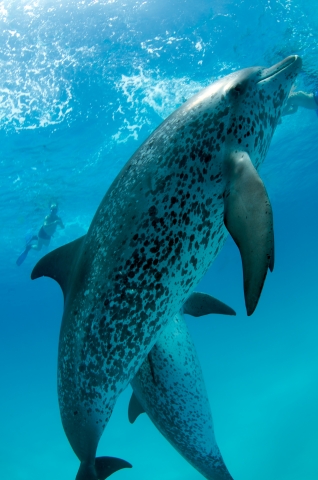Finally a dolphin that sounds easy to identify, the Atlantic spotted dolphin or Stenella frontalis must be easy to spot (no pun intended) with all the spots on its body. Oh but of course it’s not that simple, some Atlantic spotted dolphins have many spots and others not so much.
According to the Encyclopedia of Marine Mammals, spotted dolphins are born dark gray and then once they hit two to six years of age white spots start appearing. These are not polka-dot spots; instead they look more like white dolphin freckles or blotches. From the photo it looks like the pigmentation in the skin slowly starts disappearing until some adults end up mostly white with spots of gray.
They prefer to hang out in the Atlantic Ocean (obviously) near the US southeastern and Gulf coasts, off West Africa and in the Caribbean eating fish, squid and invertebrates. On average they weigh 315 pounds and grow up to 7.5 feet long. Atlantic spotted dolphins don’t do well in captivity and refuse to eat, but who can blame them. Going from the open ocean with all your friends and family to a tank without anyone; that is a brutal transition.
The spotted dolphins near the Bahamas have been observed hanging out with bottlenose dolphins when traveling or looking for food. If socializing is an indicator of mental health and physical well-being, then maybe Atlantic spotted dolphins are doing pretty well in the wild. The encyclopedia cites some decent numbers such as 31,000 living in the northern Gulf of Mexico and possibly 14,000 living off the coast from Maryland to Florida.
Numbers don’t always tell the whole story because who knows maybe there used to be 30,000 Atlantic spotted dolphins living off the southeast US Coast. But for now I want to believe the Atlantic spotted dolphins are doing well and that things are as they should be.

Lovely piece. Any news of dolphins makes me think of the wonderful, though troubling, new documentary, “The Cove.” A must-see.